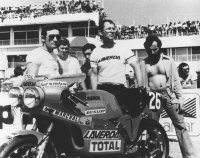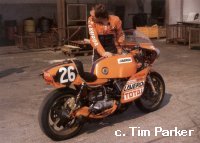THE RACE

And so with the bikes handling greatly improved, the V6 was entered in the 1978 Bol'D'or, the riders were Nico Cereghini and Carlo Perugini. It was mean, but by no means lean scaling in at 236kg ready to race, although this could easily have been reduced with the development that sadly never came. The bulk was well concealed however, the bike being impressively compact.
The revised swingarm and twin magnesium Marzocchi rear shock absorbers were obvious, but many other details had also changed. The seat structure carrying the engine oil beneath the rider was now a load-bearing member of the chassis, supporting the rear shocks. Five-spoke 18" magnesium wheels from Campagnolo helped reduce the weight, while the engine had been developed with numerous small changes including 34mm carburetors. The bodywork was quite different with a larger, more square tank for greater capacity and a re-styled three-quarter fairing finishing just under the cylinder heads with large air scoops each side. Massive twin headlights protruded from the fairing giving a very aggressive goggle-eyed look.
 Out on the track, the riders continued to struggle with the rear suspension, the rear end hopping under brakes and suffering very high rear tyre wear. None the less the engine was performing well and after eight and a half hours the bike was
running in 23rd position when the universal joint at the exit of the gearbox failed, ending their race. The team had predicted a life of around
9 hours for the joint - there was simply nothing available at the time
which could stand up to the punishment dealt out by Alfieri's brutally powerful engine.
Out on the track, the riders continued to struggle with the rear suspension, the rear end hopping under brakes and suffering very high rear tyre wear. None the less the engine was performing well and after eight and a half hours the bike was
running in 23rd position when the universal joint at the exit of the gearbox failed, ending their race. The team had predicted a life of around
9 hours for the joint - there was simply nothing available at the time
which could stand up to the punishment dealt out by Alfieri's brutally powerful engine.
The joint could easily have been replaced but would only have failed again so the decision was made to retire and work on a revised bike for the next season. However Laverda did not leave empty handed, gaining the highest four-stroke top speed of the meeting at 283km/h- an almost unbelievable 31km/h faster than the best works Honda RCB1000! The Laverda was the talk of the paddock, and it had shown a good glimpse of its potential.
Unfortunately for the motorcycling world, that potential was never realised. In response to the blazing speed of the Laverda, and the emergence of six-cylinder bikes from Honda and Kawasaki, endurance racing rules were changed for 1979 to exclude six cylinder machines. The incredible machine had effectively been made redundant at the stroke of a pen. It was a dreadful blow for the small Laverda company.
Further development was cancelled, the mighty Vee Six was project was scuttled.

